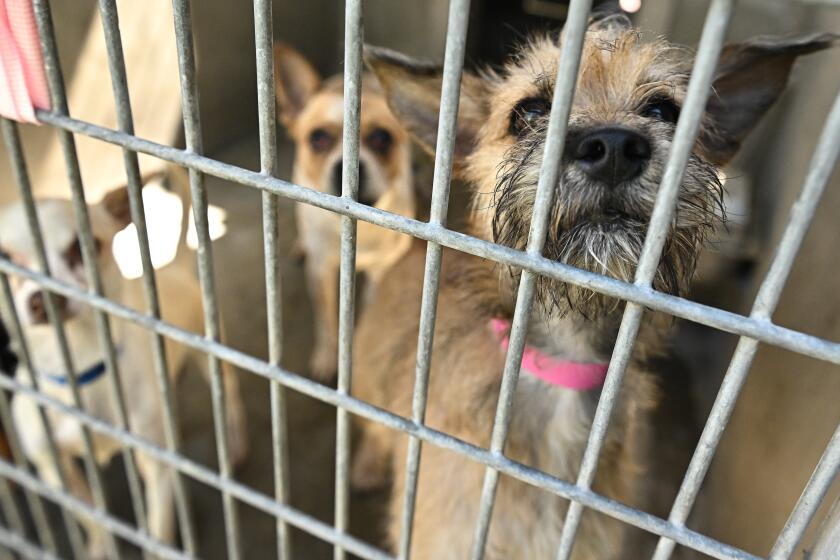Op-Ed: Enjoy the lines at Disneyland? You’ll love Elon Musk’s idea for transit
- Share via
Have you ever tried to drive out of Dodger Stadium and waited an hour to get to the freeway? Have you ever stood in an interminably long line for the Pirates of the Caribbean ride at Disneyland? Congratulations: You’ve had a preview of the bottleneck joys of Loop, Elon Musk’s idea for an underground “personal rapid transit” system.
Last week, Musk spent a night in Bel-Air explaining his grand PRT project to relieve the city’s traffic congestion. Instead of a mass transit system like a subway, PRT is individualized — you get in a small car and are taken directly to your destination, making no other stops along the way. In Musk’s version, an elevator would lower your personal car into the tunnel, or you could get in a Loop “pod” for 8-16 people, and be zipped underneath Los Angeles for $1 a ride. Musk theorized a trip from Dodger Stadium to LAX would take 10 minutes.
But first, you’d have to get your car into the tunnel. Musk’s design fails to solve that fundamental challenge of all PRT systems — which is why practically none have been built. Worse, Musk wants to cripple the already gridlocked above-ground network, also known as roads, in service to his subterranean fantasy.
The one major system like this running in America sits on the campus of West Virginia University, which built it in the 1970s. It’s not true PRT, because each car can carry 18 passengers. On a campus with 30,000 mostly pedestrian students and a few finite clusters of dorm or classroom buildings, it can make sense. In Los Angeles, a county of more than 10 million people, there are a virtually limitless number of such stops: campuses, job centers and attractions all draw large numbers of people.
Musk wants to cripple the already gridlocked above-ground network, also known as roads, in service to his subterranean fantasy.
If the Loop has too few stops, the result is an inefficient, relatively useless subway. Musk’s initial map of 60 miles of tunnels had only 23 stops and seemed to mainly be designed for his personal comfort. It conveniently includes his own commute from Bel-Air to Hawthorne, a few sports venues, a couple airports for when he has to fly, and pretty much nowhere that the bulk of the city lives or works.
If the Loop has too many stops, Musk has reinvented the slow highway, with numerous on- and off-ramps having to be accommodated. Musk seems to think he’ll solve this with tracks on multiple levels. But if more than a few cars enter or exit at a particular station at once, you’ll eventually get a snarl. It’s amusing and revealing that the artist’s rendering of Loop features just seven people waiting for the Loop pod and a six-lane street devoid of cars. That’s really lifelike, isn’t it?
At rush hour, when large numbers of people are trying to move around simultaneously, a PRT system would lead to massive jams both at the point of entry and exit, and in the tunnels themselves. It’s a simple problem of mass. Just as a lack of volume creates traffic above ground, the same problem will happen below. The London Underground moves 5 million people per day. A Tube train can carry up to 1,200 people; Musk’s cars and pods cannot have nearly that kind of capacity. I doubt there’s enough space between the surface of any city and Earth’s core to move 5 million people and their cars daily.
Worse, all those backed-up cars have to wait somewhere, making our existing roads the equivalent of the line for the Pirates of the Caribbean ride. That takes those streets out of operation, exacerbating congestion. And unless the PRT system has a stop at everyone’s house and everywhere anyone wants to go, people will still have to drive the last mile, after waiting an undetermined amount of time to get out of the tunnel.
This kind of boondoggle is what you get when a libertarian billionaire tries to solve a problem that requires collective action and shared rides. I don’t know if Musk finds the subway too dirty or the potential of having to interact with someone not in his social class too fraught, but his reinvention of an amusement park ride is both unworkable and unnecessary. The Jetsons was a cartoon; this version of it is just cartoonish.
Fortunately, Musk hates government so he’s not asking for a penny of public money for this. But he is asking for exemptions from environmental review and the underground space that could be put to use building the kind of mass transit system that can actually work.
Los Angeles is in the midst of building a transportation network poised to grow exponentially over the next 20 years. It may not fix car traffic entirely, but unlike Musk’s dream, it actually has a chance of getting you across town.
David Dayen is a contributing writer to Opinion.
Follow the Opinion section on Twitter @latimesopinionand Facebook
More to Read
A cure for the common opinion
Get thought-provoking perspectives with our weekly newsletter.
You may occasionally receive promotional content from the Los Angeles Times.










